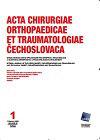羊膝上五种不同固定方法的股四头肌肌腱移植力学分析。
IF 0.4
4区 医学
Q4 ORTHOPEDICS
Acta chirurgiae orthopaedicae et traumatologiae Cechoslovaca
Pub Date : 2022-08-15
DOI:10.55095/achot2022/047
引用次数: 1
摘要
研究目的:我们旨在评估不同固定装置固定在股侧的骨栓端股四头肌肌腱移植物(QTBP)和腱端股四尾肌移植物(QT)的生物力学特性。材料与方法采用25对2岁小牛QTs和25对2年生绵羊股骨进行研究。采集具有或不具有骨塞的股四头肌肌腱的90x8mm中央部分。在髁突外侧植入8×25mm隧道。QTT用四种不同的固定装置固定,包括可调节悬吊系统(QTT-ASS,第1组)、可生物降解干扰螺钉(QTT-BIS,第2组)、钛干扰螺钉(QTT-TIS,第3组)和可调节悬吊系统+可生物降解干涉螺钉(QTT-(ASS+BIS),第4组);QTBP采用钛干扰螺钉固定(QTBP-TIS,第5组)。所有组均在伺服液压材料试验机中进行了试验。测试各组的刚度(N/mm)、肌腱的滑动(mm)和极限拉伸承载能力(N)。Kruskal-Wallis H检验与蒙特卡罗模拟技术用于比较刚度、滑移和极限拉伸载荷的非参数变量。Dunn检验用于事后分析。结果第3组固定最硬(中位数45.09N/mm)。第1组的滑移量最高(中值6.41mm)。在载荷-失效试验(464N)期间,第1组是对拉伸载荷最具抵抗力的组。在第4组中,用ASS和BIS固定QTT增加了刚度和极限拉伸载荷强度。钛螺钉固定的QTBP和QTT之间没有显著差异。钛螺钉固定QTT明显优于BIS固定(p<0.05)。尽管用ASS固定的QTT组是负载-破坏试验中抵抗拉力最大的组,但该组的滑移量也最高。因此,如果要使用ASS,在胫骨侧固定之前必须施加强大的张力,以防止移植物在隧道中进一步滑动。关键词:前交叉韧带,股四头肌腱移植,股侧,固定,生物力学性能。本文章由计算机程序翻译,如有差异,请以英文原文为准。
Mechanical Analyses of Quadriceps Tendon Graft with Five Different Fixation Techniques on the Femoral Side: an Experimental Study on Sheep Knees.
PURPOSE OF THE STUDY We aimed to evaluate the biomechanical properties of quadriceps tendon graft with a bone plug ending (QTBP) and a quadriceps graft with a tendinous ending(QTT) fixed on the femoral side with different fixation devices. MATERIAL AND METHODS Twenty-five paired 2-year-old calf QTs and 25 paired 2-year-old sheep femurs were used for this study. 90x8 mm central part of the quadriceps tendons with or without a bone plug was harvested. 8×25 mm tunnel was placed in lateral condyles. The QTT was fixed with four different fixation devices, including the adjustable suspensory system (QTT-ASS, group 1), biodegradable interference screws (QTT-BIS, group 2), titanium interference screws (QTT-TIS, group 3), and an adjustable suspensory system + biodegradable interference screws (QTT-(ASS+BIS), group 4); QTBP was fixed with titanium interference screws (QTBP-TIS, group 5). All groups were tested in a servohydraulic materials testing machine. Stiffness(N/mm), slippage of the tendon(mm), and the ultimate tensile load-bearing ability(N) of the groups were tested. The Kruskal-Wallis H test was used with the Monte Carlo simulation technique to compare the nonparametric variables of stiffness, slippage, and ultimate tensile load. Dunn's test was used for the post hoc analyses. RESULTS Group 3 had the stiffest fixation (median 45.09 N/mm). The amount of slippage was highest in group 1(median 6.41mm). Group 1 was the most resistant group against a tensile load during the load-to-failure test(464 N). Fixing the QTT with the ASS and BIS in group 4 increased both stiffness and ultimate tensile load strength. There was no significant difference between the QTBP and QTT fixed with titanium screws. Fixing QTT with titanium screws was significantly superior to fixation with BIS(p < 0.05). CONCLUSIONS This study demonstrates that QTBP fixation with TIS have no advantage over QTT fixation with TIS on the femoral side. Although the QTT group fixed with ASS was the most resistant group against tensile forces during load-to-failure test, amount of slippage was highest for this group as well. Thus, if an ASS is to be used, a strong tension force must be applied prior to tibial side fixation to prevent further slippage of the graft in the tunnel. Key words: anterior cruciate ligament, quadriceps tendon graft, femoral side, fixation, biomechanical properties.
求助全文
通过发布文献求助,成功后即可免费获取论文全文。
去求助
来源期刊
CiteScore
0.70
自引率
25.00%
发文量
53
期刊介绍:
Editorial Board accepts for publication articles, reports from congresses, fellowships, book reviews, reports concerning activities of orthopaedic and other relating specialised societies, reports on anniversaries of outstanding personalities in orthopaedics and announcements of congresses and symposia being prepared. Articles include original papers, case reports and current concepts reviews and recently also instructional lectures.

 求助内容:
求助内容: 应助结果提醒方式:
应助结果提醒方式:


